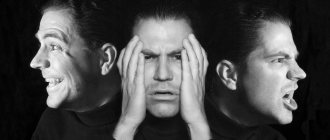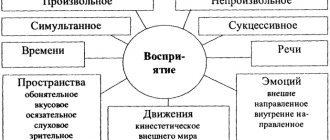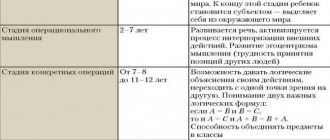Thought disorders
Acceleration of thinking is characteristic of the state of mania and hypomania, manifested by a rapid pace of speech, jumps of ideas, most of which remain unspoken. The focus and depth of reasoning is impaired - patients speak quickly and a lot, and do not have time to comprehend their own speech. With slow thinking, characteristic of depression and asthenia, the number of associations per unit of time decreases. The rate of speech decreases, patients experience difficulties in selecting words and forming sentences. Mentism is found in schizophrenia. It has the character of a violent symptom and occurs as an attack of an influx of diverse thoughts that are not formalized into words. With sperrung, patients feel a sudden “emptiness” in the head, the absence of any thoughts or ideas.
Decreased generalization correlates with general intellectual development. At the zero level, patients cannot identify individual signs and properties of objects. They perceive them entirely, unable to analyze them: determine their purpose, functional features, or class membership. Patients with a specific level of generalization combine objects according to external and situational characteristics. Their thinking is tied to visual images, operating with concepts is difficult. For example, they combine a shovel and a dog - they are “outside”, scissors and pieces of furniture - they are “in the house”. The selection of the “tools” category is not available to them. At the functional level of generalization, patients are able to determine the characteristics of objects that are not visually displayed (actions, manipulations). This is a simple level of abstraction. Example: a car and a tractor are combined, since both “drive”, but are not called by the general concept of “transport”.
When the fluidity and coherence of thinking changes, amorphous judgments are observed. It is manifested by the presence of logical coherence between parts of a sentence and individual sentences, but by the loss of the overall meaning of the narrative. In the conversation, it seems that the patients are “floating” and find it difficult to express the key idea. When reasoning, patients talk for a long time and fruitlessly about the topic of conversation, do not draw conclusions and do not answer the questions posed. Thematic slippages are a sudden change in topic, lack of logical relationship between the previous and next sentence. With such a symptom, paralogical thinking is possible - distorted logic, understandable only to the patient.
Thoroughness is characterized by excessive “stuckness” on details, viscosity and stiffness of associations. Patients delve deeper into their own reasoning and fixate on insignificant details. Incoherent thinking is the absence of connections between words in a sentence, and vergiberation is a violation of coherence between syllables. Both disorders are characteristic of severe forms of schizophrenia. Perseverations and speech stereotypies are repetitions of individual words, phrases and sentences. Observed in organic diseases and severe endogenous pathologies.
According to the content, thinking is divided into affective, egocentric, paranoid, obsessive and overvalued. In people with an affective form of thinking, emotionally charged ideas and rapid and involuntary changes in the process under the influence of external stimuli (significant and insignificant) predominate. With egocentric thinking, patients are fixed on the ideality of their own personality, the need and uselessness, the usefulness and harm of everything that happens.
Paranoid thinking is represented by delusional ideas. Delusion is an erroneous conclusion formed on a pathological basis - altered logic or affective experiences. Delusions of relation, persecution, grandeur, jealousy, guilt, hypochondriacal and erotic delusions are common. In children, the paranoid form of thought processes is represented by delusional fantasies and pathological fears (unreal worlds, bizarre creatures, fear of the corner of the room). Overvalued thinking is focused on leading personal tendencies, changes the direction of the patient’s life - the idea of organizing a revolution, inventing a perpetual motion machine. With obsessive thinking, stereotypically repetitive thoughts, memories, fears, and rituals arise. They are involuntary and conscious.
Delusional disorders and their features
When studying disorders of the mental sphere in the form of ideas, it is necessary to divide them into at least several types. They are:
- delusional;
- super valuable;
- dominant.
Delusional ideas are understood as painful distortions of real-life facts. Patients make incorrect conclusions that cannot be corrected through rational persuasion.
Almost any delusional state develops in approximately the same way and is accompanied, first of all, by the appearance of delusions of attitude. The patient thinks that everyone treats him badly, suspects him of something, or wants to harm him. When the disease begins to progress, a full-fledged picture of persecutory delusion develops: the patient seems to be surrounded only by hostile people who do not leave him alone twenty-four hours a day. Enemies exercise constant control over the patient and wish for his death. The patient's behavior is characterized by extreme caution, since he believes that almost the whole world has conspired against him.
There is also delirium of physical influence associated with a fantastic plot. Such patients think that they are being influenced by:
- cosmic energy;
- cosmic rays;
- chemical substances;
- radio equipment;
- alien agents;
- hypnosis.
Delusions of physical influence are often accompanied by ideas that enemies “read minds,” “put other people’s thoughts into their heads,” and so on.
Delirium can also be hypochondriacal: patients constantly say that they have some kind of incurable and fatal disease. They discover all its symptoms in themselves, for example: “the heart shrank and sank into the stomach,” “the aliens stole the internal organs and replaced them with green liquid,” etc.
In elderly people, against the backdrop of the development of dementia, delusions of damage occur, namely: old people say that everyone wants to rob them and lock up their property. And of course, there is one of the most popular types of delusion - grandeur, when the most ordinary schizophrenic considers himself a great poet, musician, or even even declares that he is one of the great historical figures.
Free consultation on training issues
Our consultants are always ready to tell you about all the details!
Delusions of jealousy are most typical of chronic alcoholics, often males, who are convinced that their spouse is constantly cheating on them. At the same time, alcoholics always try to find evidence of non-existent betrayals, striking others with the absurdity of their thoughts and behavior. Gradually, such delirium takes on a generalized form and becomes one of the leading symptoms of the disease.
What are the reasons for this problem?
In most cases, a disorder of human thinking processes occurs due to biological pathologies and disorders. They provoke lesions of the brain substrate of various types. Moderate or mild forms of the disorder can be triggered by individual characteristics in the formation of reactions to stress and other traumatic situations that arise in life. Among the most common causes of thought disorder syndrome are:
- biochemical changes occurring in brain cells;
- TBI;
- psychoses;
- degenerative pathologies of the central nervous system;
- epilepsy;
- inflammatory processes of the central nervous system;
- malignant and benign neoplasms formed in the brain;
- neuroses, stress.
Key Features
Most people believe that schizophrenia is a split personality disorder. However, this is too simple a definition. In fact, it is a more complex mental pathology that covers many different disorders. Most of them have nothing to do with the formation of new personalities in a person’s head.
According to ICD-10, a diagnosis of schizophrenia (F20.0-F20.3) can be made if at least one of the following symptoms is observed:
- Putting/taking away thoughts, their openness to others, “echo” of thinking. It seems to a person that strangers hear his thought process (or other people influence him by planting ideas or replacing memories).
- Crazy ideas. First of all, schizophrenics are concerned about delusions of influence. They are sure that their body or thoughts are influenced by surrounding or otherworldly forces, for example, aliens.
- Hallucinations - auditory, visual and tactile. Patients hear, see and touch what is not in reality.
- Persistent delusions. They are associated with culture, politics, invention, etc. As a rule, such nonsense sounds ridiculous or even fantastic.
A person may also be diagnosed with schizophrenia if two of the following signs are present:
- Persistent hallucinations of any type, accompanied by delusions, which appear over the course of a month.
- Sperrungs and neologisms are breaks in thinking, the use of non-existent words in speech.
- Catatonic syndrome - psychomotor (motor) disorders. The patient is either highly excited or falls into a stupor, freezing in an unnatural position for several hours.
- Negative symptoms: apathy, poverty of speech, lack of initiative, loss of interests, inadequacy of emotions, alienation, etc.
The last group of symptoms, negative, can also be observed in depression. However, in the presence of hallucinations, sperrungs or catatonic syndrome, which develop against the background of apathy and other signs of a negative type, the question arises of making a diagnosis of schizophrenia.
Obsessive ideas and their characteristics
The main feature of obsessions is that patients have thoughts that they cannot get rid of - even if they have a critical attitude towards them. This is the difference between such patients and delusional patients: as is known, they are firmly convinced of the correctness of their conclusions. If a patient suffering from obsessive-compulsive disorder consults a psychotherapist in a timely manner, the treatment will certainly give a positive result.
There are also obsessive desires, or manias, and obsessive fears, which are called phobias.
Here are some examples of obsessive urges:
- arithmomania - an obsessive desire to count;
- onomania - remembering the names of all the people the patient has once seen;
- kleptomania - theft of absolutely unnecessary things;
- Pyromania - a tendency to set fires.
Examples of obsessive fears:
- agoraphobia - fear of open space or large crowds of people in a public place;
- claustrophobia - on the contrary, fear of small spaces;
- nosophobia - fear of being infected with a dangerous disease, etc.
It should be noted that obsessive-compulsive disorder syndromes are characteristic of people with an anxious-hypochondriac personality type, as well as schizophrenics and neurotics.
Memory impairment
During a pathopsychological examination to identify memory pathology, the following questions seem most important:
- the problem of the structure of mnestic activity of mediated and non-mediated, voluntary and involuntary memorization;
- the question of the dynamics of the mnestic process;
- question about the motivational component of memory.
Korsakoff's syndrome is an immediate sign of memory impairment. One of the most studied disorders of immediate memory is a memory disorder for current events, in which memory for past events remains relatively intact, the so-called Korsakov syndrome, which was described by the famous Russian psychiatrist S.S. Korsakov in severe alcohol intoxication. This type of memory impairment is often combined with confabulations about current events and disorientation in place and time. The last two signs could be weakly expressed, but the first is always extremely pronounced and constitutes the main radical of this suffering (forgetting current events).
Pathopsychological examination revealed progressive amnesia. Memory impairment often extends not only to current events, but also to past ones: patients do not remember the past, confuse it with the present, they shift the chronology of events; disorientation in time and space is revealed. At times such memory disturbances are grotesque in nature.
Violation of mnestic activity
The memory impairments described above, identified by pathopsychological examination, were mainly stable. Although the degree of their severity could change, the main radical of these disorders (violation of temporal characteristics, amnestic disorientation) remained persistent.
In other cases, the memory of mentally ill patients may be impaired in terms of its dynamics. Patients remember and reproduce material well for a certain period of time, but after a short time they cannot do this. Fluctuations in their mnestic activity come to the fore. If such a patient is asked to remember 10 words (with ten presentations) and depict the number of words reproduced in the form of a curve, then the latter will have a broken character. The patient can remember 6-7 words after the second or third presentation, after the fifth - only 3 words, and after the sixth - again 6-8.
It is noteworthy that such disturbances in the dynamics of mnestic activity rarely appear in patients as an isolated monosymptom. Pathopsychological examination reveals the lability of all forms of their activity, their cognitive and effective-emotional spheres.
Violation of the dynamics of mnestic activity manifests itself in combination with the intermittency of all mental processes of patients and is essentially not a memory impairment in the narrow sense of the word, but an indicator of the instability of the mental performance of patients in general, its exhaustion.
Violation of mediated memory
Memory is a complex organized activity that depends on many factors, the level of cognitive processes, motivation, dynamic components, mental illness. By changing these components, it also destroys mnestic processes in different ways. The introduction of a mediation operation improves the memory of healthy people. However, in a number of patients with memory impairment, the mediating factor becomes an obstacle.
Thus, the violation of controllability, selectivity of mental processes, the replacement of the purposefulness of the act with stereotypes or random fragmentary actions were factors that impeded the process of mediation, making it fundamentally impossible. Disturbances in mnestic activity reflect the differently altered structure of the motivational sphere of patients. The motivational component is integral in the structure and flow of memory processes.
Cognitive sphere in schizophrenia
First of all, schizophrenia is reflected in the perception of the surrounding reality. Changes in this area may indicate the beginning of the development of a psychopathological process, which will subsequently affect a person’s thinking and emotionality. He begins to perceive the world too subjectively, which leads to limited judgments, unrealistic or fantastic ideas.
Changes in perception are assessed using the Rorschach test, which consists of showing the patient pictures with unusual images. The subject must say what exactly he sees on the cards. As a rule, he is shown three types of images:
- deficient - “man without a head”;
- dissociative - “flattened cat”;
- symbolic - “punishment of evil.”
Analysis of the test is quite complex. You can go through it on the Internet, but you should not draw any conclusions. Only a specialist can give a normal assessment.
Attention also has its own distinctive features in schizophrenia. It is disrupted even when the patient’s memory and high intellectual level are preserved. This indicator is studied using the Schulte test, or “switch counting,” which determines how quickly a person voluntarily or involuntarily switches from one object to another. Usually, in schizophrenia, voluntary attention suffers more. At the same time, the subject does not dwell on the indicated errors, and practically does not react to the experimenter’s reactions.
Memory in schizophrenia can suffer when motivation decreases. But this phenomenon is also quite complex. In some patients it remains completely, in others it disappears partially or completely. Sometimes the patient cannot say for sure whether a particular event occurred or not.
There is also a symptom of schizophrenia called confabulation, when the brain is filled with false memories. The current ability to remember, that is, short-term memory, is tested using tests, including the “pictogram” technique.
Schizophrenia can take years to develop. Before the first attack, a person almost always does not understand that he is sick. When he is taken to the clinic, which happens during an exacerbation of the disease, a complex of symptoms is already observed. Some of them are associated with formal thinking disorders, including meaningfulness, flexibility and criticality. The degree of brain damage is determined by the type of schizophrenia and the intensity of its development.









